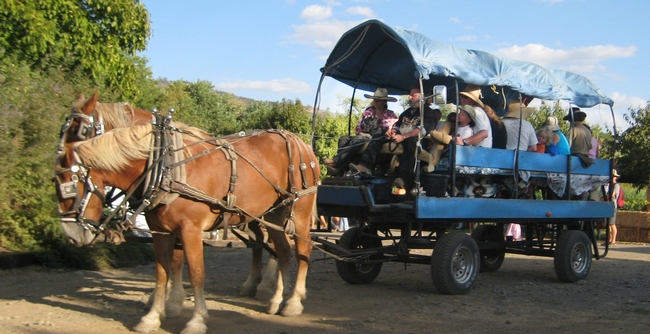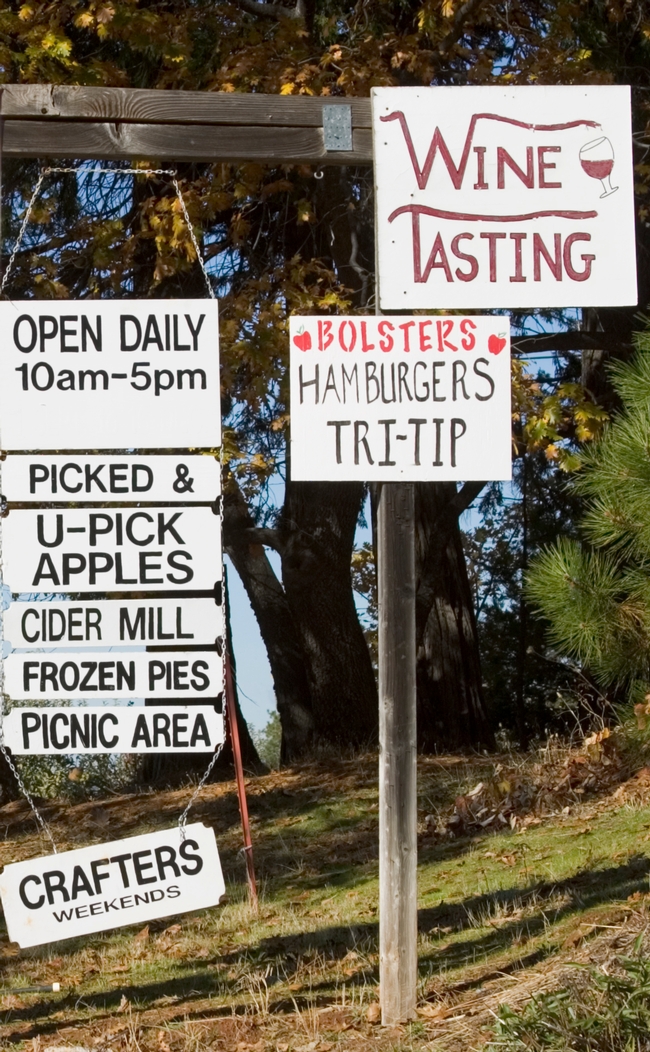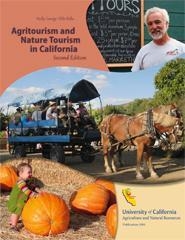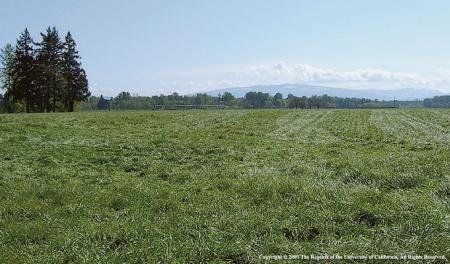Posts Tagged: Penny Leff
Agritourism Intensive classes offered in Quincy, Modesto and Redding
Farmers and ranchers are invited to attend an agritourism planning course being offered by UC Agriculture and Natural Resources in three Northern California locations this winter. UC ANR Cooperative Extension is working with local agricultural and community organizations, tourism professionals, and experienced agritourism operators to offer the three-session Agritourism Intensive beginning in December in Quincy, Modesto and Redding.
Farmers and ranchers who are considering, starting or expanding agritourism or nature tourism businesses on their farms or ranches are invited to register for this low-cost, hands-on course.
“Agricultural operations offer a wealth of beautiful natural resources and unique experiences with local farmers and ranchers,” said Holly George, livestock and natural resource advisor and director for UC Cooperative Extension in Plumas and Sierra counties. “With prices, competition and water situations the way they are all over California, it can be hard to make a living. The UC ANR workshops will give farmers and ranchers the contacts and tools to more successfully grow and market their individual agritourism enterprises, adding to their income and helping spread the risk of tough production years.”
Participants will learn about the variety of potential businesses, including farm stands, U-Pick operations, farm stays, event hosting, tours, festivals, education and outdoor recreation. Each participant will receive a free copy of the UC ANR handbook, “Agritourism and Nature Tourism in California,” which will be used as the text for the class.
Experienced agritourism operators and experts will discuss business planning, risk management, regulatory compliance and marketing. Class instructors will provide individual guidance and help participants form a supportive network as they plan and develop their own agritourism or nature tourism businesses.
Registration is open and space is limited so please sign up early.
Plumas County Agritourism Intensive:
Register: http://ucanr.edu/agtourplumas
Dates: Tuesdays, Dec. 1, 2015, Jan. 12 and Feb. 23, 2016
Time: 9 a.m. to 4 p.m. each session (lunch provided)
Location: Mineral Building, Plumas County Fairgrounds, Quincy, CA 95971
Cost: $50 for 3-session course (only $20 for additional participants from same family or business)
Shasta County Agritourism Intensive:
Register: http://ucanr.edu/agtourredding
Dates: Wednesdays, Jan. 6, Feb. 10 and March 16, 2016
Time: 8:30 a.m. to 4 p.m. each session (lunch provided)
Location: The McConnell Foundation Lema Ranch, 800 Shasta View Drive, Redding, CA 96003
Cost: $50 for 3-session course (only $25 for additional participants from same family or business)
Stanislaus County Agritourism Intensive:
Register: http://ucanr.edu/agtourmodesto
Dates: Thursdays, Dec. 10, 2015, Jan. 21 and Feb. 11, 201
Time: 8:30 a.m. to 4 p.m. each session (lunch provided)
Location: Harvest Hall, Stanislaus Co. Ag. Center, 3800 Cornucopia Way, Modesto, CA 95358
Cost: $50 for 3-session course
For more information, contact Penny Leff, UC ANR Cooperative Extension agritourism coordinator, at paleff@ucdavis.edu or (530) 752-7779.
Funding for this project was provided by the Washington State University Western Center for Risk Management Education and the USDA National Institute of Food and Agriculture.
Agritourism an option in the San Joaquin Valley
Even though the typical San Joaquin Valley farm is focused exclusively on food production, local growers can profit from increasing interest in agritourism, reported Helen Tracey-Noren in the Fresno Bee. The concept was touted at a recent forum in Fresno where CDFA secretary Karen Ross and the CEO of Visit California, Caroline Beteta, spoke about the agritourism trend.
"It's about, 'here's what farmers and ranchers are doing as your neighbors,' their environmental stewardship," said Ross. "It's about the pride of what we produce here, and it's about this wonderful lifestyle and supporting the economy at the same time."
Penny Leff, the agritourism coordinator with the UC small farm program, also participated in the event. She said that from 2007 to 2012, agritourism has picked up in California.
"Most families don't have anyone on the farm anymore to go visit," Leff said. "Farmers are interested in educating the public in what's going on, what goes into making the food. They really want to share with the public and make them understand."
The story gave the example of Debbie and Jim Van Haun, a Sanger couple who opened Sequoia View Bed and Breakfast about 15 years ago, and fixed up an adjoining vineyard in 2003. They said that during the summer season, the area could use more businesses to handle all the tourists.
Agritourism and Nature Tourism in California - Second Edition
By Holly George and Ellie Rilla
151 pages, $25
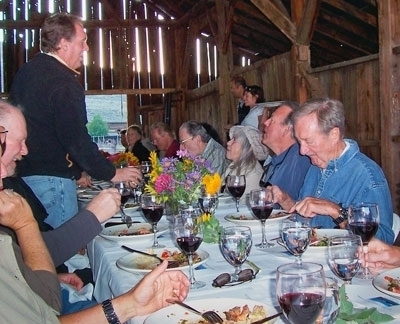
Offering dinner in a winery barn is a form of agritourism.
Putting agriculture back in the county fair experience
UC Cooperative Extension and the Fairs and Expositions branch of the California Department of Food and Agriculture teamed up this summer to host meetings at seven county fairs to see how to bring back the quaint agricultural flavor of decades past.
Penny Leff, UC Cooperative Extension agritourism coordinator, and Diana Paluszak of Fairs and Expositions brought together small-scale farmers, fair officials, tourism bureau representatives and others for the regional meetings.
“We need to keep the agricultural heritage of our fairs alive,” Leff said. “There isn’t a pot of money for this, so developing partnerships and working together is important.”
The final meeting of the 2012 season took place at the Big Fresno Fair in October. Even though it is located in the No. 1 ag county in the world, fair visitors would be hard-pressed to find anything farm-fresh to eat.
Big-name bands, horse racing, a brightly lit midway, and endless food booths hawking cotton candy, chocolate-dipped ice cream cones, foot-long corn dogs and cinderblock-sized tangles of curly fries, are the hallmarks of fair time. Students visiting the fair on field trips are kept out of the livestock building for health and safety reasons. The agriculture building is an impressive, but untouchable, produce display.
“I love the Fresno Fair’s ag building,” said Elisa Hays, creator of ‘The Cutest Show on Earth,’ which contracts with the Fresno Fair and many other fairs in California and Texas to provide what it calls agritainment. “It’s a beautiful art gallery for fruit and vegetables. But it’s not interactive. It needs whimsy and fun.”
Nori Naylor of Naylor’s Organic Family Farms in Tulare County, one the program participants, said she would like to see more emphasis at the fair on individual farms and farmers, and find a way to give visitors the opportunity to try fresh fruits and vegetables grown in the area. For more of Naylor’s thoughts, see the video clip below.
Some California communities have been successful in changing fair culture. The Marin Fair includes a certified farmers market and all food vendors are required to offer something healthful. The Yolo County Fair hosts an opening night gala with more than 50 farms and local food vendors handing out samples of their products.
Ideas about how fairs can help expand awareness and build support for local farms were raised at the conferences. In Tehama County, for example, small-scale farmers have rent-free access to a “marketplace,” where they can sell local produce. The California State Fair included a greenhouse demonstration of “aquaponics,” in which vegetables and fish are raised with recirculating water that complements each other's nutrient and water treatment needs.
Fairground facilities can also support small-scale farmers in the off season.
In Tulelake, for example, the fairgrounds will be the site of farmworker housing for the strawberry industry. In Calaveras County, organizers are considering building a meat processing facility so small-scale ranchers can have their grass-fed beef prepared for market. The kitchens at fairgrounds could be used as incubator kitchens for small-scale farmers who wish to produce value-added products but don’t have access to commercial facilities.
Leff and Paluszak are in the process of planning a mobile agricultural education exhibit to be displayed at four urban fairs in 2013.
“We hope to have something specific to each local fair, plus farmers markets, community supported agriculture, and agritourism information,” Leff said. “We plan to have interactive activities, farm fresh food to buy and opportunities to meet farmers in the area.”
Leff gives an overview of the 2012 program in the video clip below.
Forget five-star hotels, book a farm
Sunset Magazine ran an article this month encouraging readers to consider a farm stay for their next vacation. Beside a tranquil and scenic break from the office, farm visits help small-scale farmers sustain their operations, the article said.
“Farmers are recognizing that people are willing to pay for this experience,” said Penny Leff, agritourism coordinator for the University of California small farm program, whose researchers have seen a boost in the number of farms catering to visitors in recent years.
The small farm program maintains an online list of farms at http://calagtour.org that offer a wide range of agritourism opportunities to the public, from farm stays to U-pick operations, petting zoos, corn mazes, hay rides and farm stores.
The Sunset article details what it calls the "Top 8 Agritourism Experiences," including cattle herding, chicken butchery, wine making and goat cheese making.

Opening a ranch for hiking and birdwatching is another form of agritourism.
UCCE plans meeting to help producers with new water rules
Farmers and ranchers who use river or stream water must start submitting precise monthly records to the California Water Quality Control Board this year, said an article by Tim Hearden in Capital Press.
Before the new law took effect, the water board asked landowners for estimates, said Allan Fulton, a University of California Cooperative Extension advisor who serves Colusa, Glenn and Shasta counties. Fulton is an irrigation and water resources expert.
"There is a statewide effort at trying to more precisely understand and quantify how water is being used," he said.
UC Cooperative Extension will host a workshop March 31 to discuss the new requirement.
"I've had enough questions that I thought we ought to organize something," said Larry Forero, a UCCE director and advisor in Trinity County who specializes in livestock and natural resources.
Agritourism generates income, promotes farms
Tim Hearden, Capital Press
Agritourism, or activities and products offered on working farms to generate extra income from visitors, is a growing movement in California.
A recent UC survey determined that about 2.4 million visitors came to California farms in 2008 to enjoy some facet of agritourism, which could include lodges and cabins, pumpkin patches, corn mazes, "U-pick" operations and special events such as weddings and conferences.
"I think it really does help" farms, said UC agritourism coordinator Penny Leff. "It helps their name recognition if they're selling at the farmers' market or local stores. It helps in general for people to understand what farming's about, that food comes from farms."

